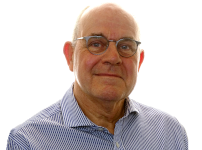

Simon Bartle, Visual Arts Correspondent
Barbara Hepworth: Musée Rodin, Paris

"I, the sculptor, am the landscape". Barbara Hepworth
What do Barbara Hepworth, and Paris have in common? They have both deservedly earned the epithets 'pioneering' and 'revolutionary'. The Musée Rodin is therefore a worthy stage, on which, to celebrate these shared traits with their new exhibition 'Barbara Hepworth'.
The Musée Rodin is one of the few museums in France to have previously exhibited Hepworth's work in her own lifetime, but that was over 60 years ago.
Dame Barbara Hepworth (1903-1975), born in Wakefield, Yorkshire was from the outset a visual revolutionary, who from the 1930's onwards, explored abstraction in her sculpture. Through abstraction, Hepworth pioneered what sculpture can be, and she was the first sculptor to discover the possibilities. Abstraction challenged the senses, and Hepworth created works, which arguably on first sight were difficult to understand. Her work was less about the answer, and more about the questions that it asked. Hepworth, and her contemporaries, challenged the viewer to think about what they saw, and not to simply passively look. Through throwing down the gauntlet in this manner, Hepworth helps us on the road to developing a deeper understanding, not only of her sculpture, but also of ourselves.

The exhibition presents Pelagos (1946), on loan from the Tate. This more than any other piece in the exhibition, embodies the new abstract form. It is all about emotions, and those are translated into this sculpture. Does this elm, paint and string configuration, represent a wave, or a shell? If you are asking that question, then you are asking the wrong question. This work is, we contend, all about feeling, you just want to hold it, caress it, and enjoy it for what it is, and not for what it might be. You may of course interpret the work completely differently, and that is your right. However, what is certain is that Hepworth's work, is revolutionary in the way that sculpture is both made, and presented.

Barbara Hepworth says that actually, she was heavily influenced in her childhood, by the West Riding of Yorkshire landscape, in which she grew up. She is unequivocal, in that she maintains it was wholly responsible for shaping her thinking, and in her autobiography she says, "the hills were sculptures; the roads defined the form. Above all, there was a sensation of moving physically over the contours of fullnesses and concavities, through hollows and over peaks - feeling, touching, through mind and hand and eye". Undoubtedly the landscape of Cornwall, her adopted county, also played an important part in the direction of her work.

Also by Simon Bartle...
Pre-Raphaelite Knights: Reinventing The Medieval World At The Bowes MuseumBill Brandt And Henry Moore: At The Hepworth, WakefieldTurner: Northern Exposure At The Mercer Art Gallery, HarrogateDora Maar: Tate ModernNorman Cornish: The Definitive Collection At The Bowes Museum, Co DurhamMusée Rodin
LOCATION: 77, Rue de Varenne, 75007, Paris, France
Metro : Varenne (line 13) or Invalides (line 13, line 8)
R.E.R : Invalides (line C)
Bus : 69, 82, 87, 92 Vélib' : 9, Bd des Invalides
Car parks : Bd des Invalides
Opening Times:
Tuesday to Sunday 10.00–18.30
Last tickets sold at 5.30pm
Closed:
Museum closed on 1 January, 1 May and 25 December. The museum will close on 24 and 31 December at 16:45. Last ticket at 16:15.
ADMISSION MUSÉE RODIN - PARIS:
Full Price 12€, Concessions 9€
For more information please see http://www.musee-rodin.fr/